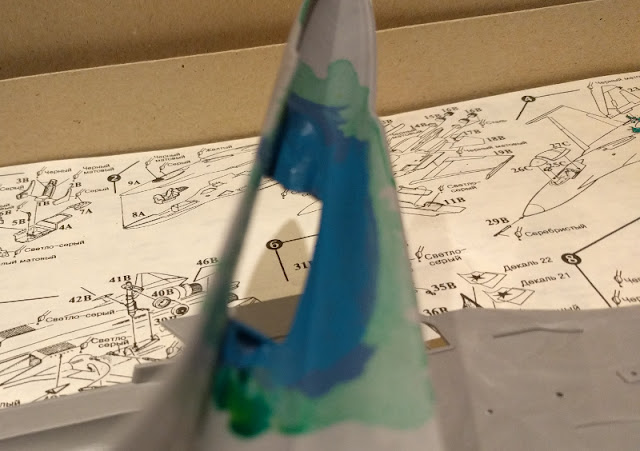Brushing on some paint
My first idea was to paint the subassembly I finished the last time and the inner parts of the upper airframe half with Jade Green and then work on that base depending on how it ended up looking. This was a very fine idea but it got foiled by the paint that had dried inside the bottle after all these years. I then tried a slightly greener paint (Goblin Green) but that was more like a wash than anything else due to some ancient mistreatment of mine. Graaaaah. I shouldn't have applied it anywhere, but I tried and it failed.The pilot's dashboard's cover I painted light grey (VMA 71276 USAF Light Grey) at this point. I had a suspicion I might attack it somehow later on.
Base mixture
Before any further attempts I glued the workstation onto the lower airframe piece. I thought that this way I could maybe paint it a bit more easily and cleanly.For the new improved cockpit interior I mixed some blue (VMA 71111 UK Mediterranean Blue) with a bit of green (VMA 71017 Russian Green 4BO) and repainted all the fugly bits. The ejection seat I left pretty much untouched for now.
Shading
After a chat with a colleague who has painted Warhammer pieces just for the fun of it I knew that the nearest GW shop was practically next door from my workplace. I remembered that at some point Citadel had had a colour called something like Hawk Turquoise and it sounded like something I should consider for this case.Of course they had changed their paint lines, names and everything again since the last time I had perused their wares. I bought two paints that I thought sounded and looked like something useful. Then I painted over the mix of mine with a different blue (Citadel "Layer" Ahriman Blue).
To give the IP some life I took a couple of surfaces under my aim and painted those with a lighter blue (Citadel "Layer" Temple Guard Blue) to represent a case of "here's a new module and it was only painted with a different mix, so stop whining, comrade". This was all a bit more blue than I had intended and I thought if I should wash them with green but I realized that it wouldn't most likely work at all as I wanted to. I let them be to avoid ruining anything.
The IP and controls
This Su-27 was clearly modeled after a source older than myself, a thing which I assumed true based on the amount of round dials and nothing else on the instrument panel. All the modern humbug like MFDs and large panels were not there. Not that any of the planes on this scale had ever jumped at me in a good or bad way with their panels (for some reason I had this feeling that the IP bits were always the same, no matter which plane you were building).All I wanted for it was that it was good enough, meaning something I'd believe at a glance. If one could see anything through the canopy later on.
References
I spent a while in the image search world for relevant sources. Of the things I found I copied a few locally as backups and added an URL to the one I had taken, as the caption. Maybe they'd be enough for this project. |
| [SOURCE] |
 |
| [SOURCE] |
 |
| [SOURCE] |
 |
| [SOURCE] |
 |
| [SOURCE] |
Imitating life
Detailing began with the most obvious thing: I painted a vertical white (VMA 71279 Insignia White) line through the center of the panel and a pair of horizontal smaller lines to divide the dialspace somehow. Those extra lines wouldn't be noticeable at all later on. As far as I had understood the point of the center-axis line was to help the pilot whenever the plane ended up in a difficult spin, stall or whatnot. I could not even imagine the methods the instructors used to use to get the "align the stick with that white band" to become a no thought -operation in certain circumstances.After that I painted all the lumps and protrusions on the IP and the armrests with black (VGC 72051 Black). In addition I also did the base and the grip part of the joystick black and added a couple of small dots onto the joystick's tip as hat switches and such. The ejection seat I also painted black in the end even though I had entertained the thought of doing that with Russian Green instead. As usual, the seat was ascetic, so I didn't go and paint any harnesses, straps or anything that one could see in the reference images above.
Finally I decorated a couple of the dials and some buttons with red (VMA 71085 Ferrari Red) and added a dot to the joystick's end to function as some sort of a trigger. Again, I doubted anyone'd ever notice them, but they were there anyway. The funny thing I've also noticed on these 1:72 planes is that the ejection seat triggering handles or loops have never been modeled in the kit, which is funny because I've always thought that'd be a good, visible detail.








No comments:
Post a Comment